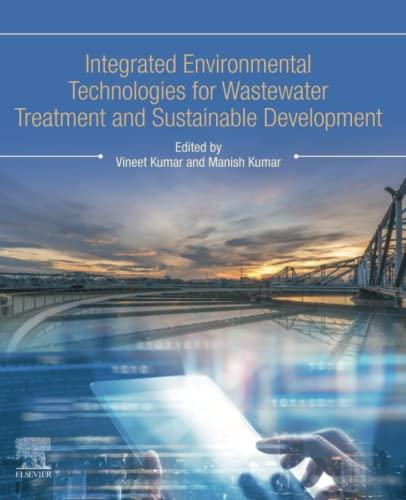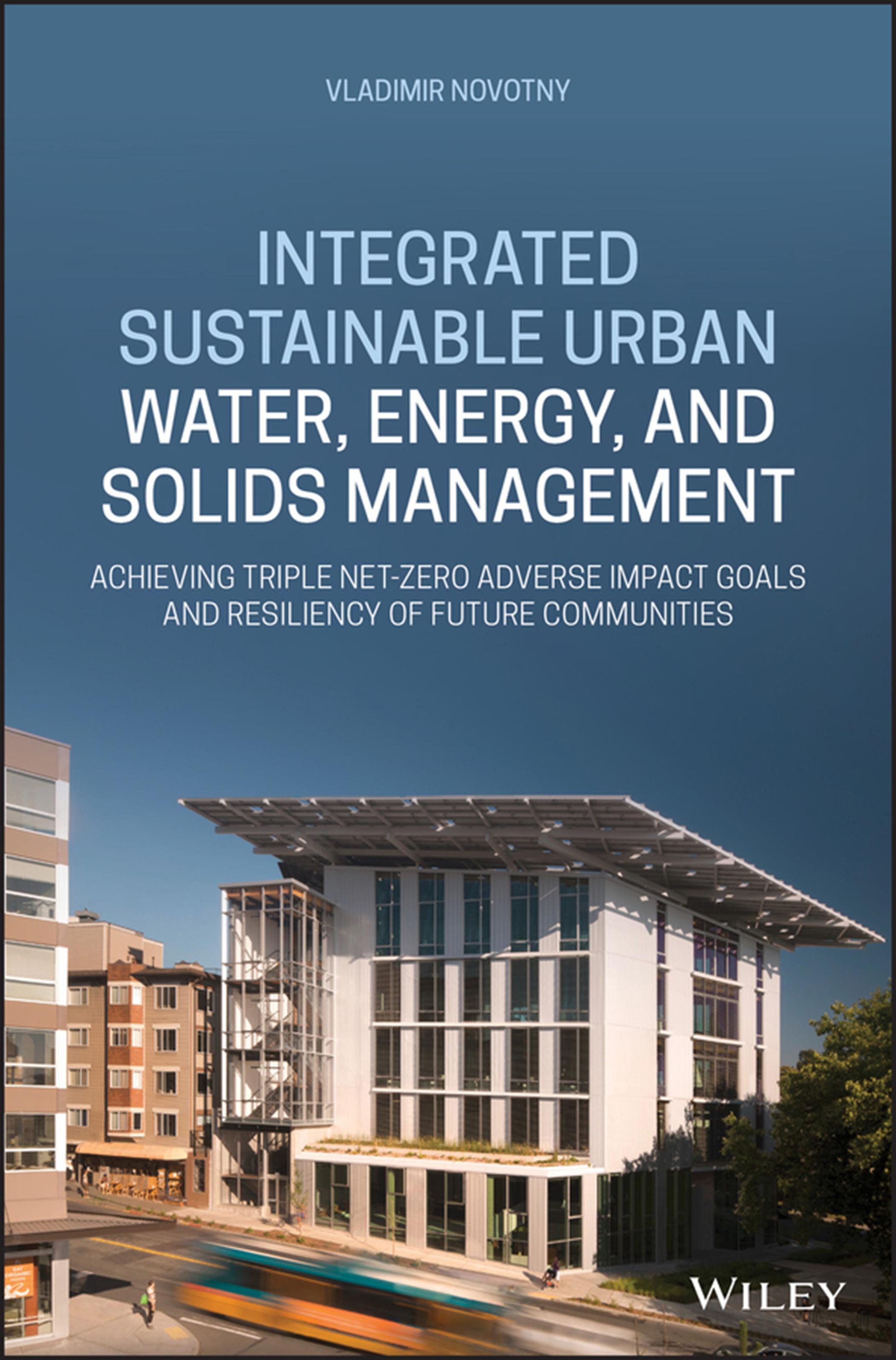Integrated Sustainable Urban Water, Energy, and Solids Managementpresents an integrated and sustainable system of Vladimir Novotny
Visit to download the full and correct content document: https://ebookmass.com/product/integrated-sustainable-urban-water-energy-and-solids -managementpresents-an-integrated-and-sustainable-system-of-vladimir-novotny/
More products digital (pdf, epub, mobi) instant download maybe you interests ...
Integrated Environmental Technologies for Wastewater Treatment and Sustainable Development Vineet Kumar
https://ebookmass.com/product/integrated-environmentaltechnologies-for-wastewater-treatment-and-sustainabledevelopment-vineet-kumar/
Technologies for Integrated Energy Systems and Networks
Giorgio Graditi
https://ebookmass.com/product/technologies-for-integrated-energysystems-and-networks-giorgio-graditi/
Physics and Technology of Sustainable Energy E. L. Wolf
https://ebookmass.com/product/physics-and-technology-ofsustainable-energy-e-l-wolf/
Vulnerability and the Corporate Immune System: An Integrated and Systemic Approach to Risk Management Alessandro Capocchi
https://ebookmass.com/product/vulnerability-and-the-corporateimmune-system-an-integrated-and-systemic-approach-to-riskmanagement-alessandro-capocchi/
Distributed Energy Resources in Local Integrated Energy Systems: Optimal Operation and Planning Giorgio Graditi
https://ebookmass.com/product/distributed-energy-resources-inlocal-integrated-energy-systems-optimal-operation-and-planninggiorgio-graditi/
Exergy. Energy, Environment and Sustainable Development
3rd Edition Ibrahim Dincer And Marc A. Rosen (Eds.)
https://ebookmass.com/product/exergy-energy-environment-andsustainable-development-3rd-edition-ibrahim-dincer-and-marc-arosen-eds/
Farming System And Sustainable Agriculture Alok Kumar
Patra
https://ebookmass.com/product/farming-system-and-sustainableagriculture-alok-kumar-patra/
Sustainable Production System: Eco-development versus Sustainable Development Clément Morlat
https://ebookmass.com/product/sustainable-production-system-ecodevelopment-versus-sustainable-development-clement-morlat/
Sustainable Water Purification M. R. Islam
https://ebookmass.com/product/sustainable-water-purification-m-rislam/
INTEGRATEDSUSTAINABLE URBANWATER,ENERGY, ANDSOLIDSMANAGEMENT VladimirNovotny
Thiseditionfirstpublished2020 ©2020JohnWiley&SonsInc.
Allrightsreserved.Nopartofthispublicationmaybereproduced,storedinaretrievalsystem,ortransmitted,in anyformorbyanymeans,electronic,mechanical,photocopying,recordingorotherwise,exceptaspermittedby law.Adviceonhowtoobtainpermissiontoreusematerialfromthistitleisavailableat http://www.wiley.com/go/ permissions
TherightofVladimirNovotnytobeidentifiedastheauthorofthisworkhasbeenassertedinaccordance withlaw.
RegisteredOffice
JohnWiley&Sons,Inc.,111RiverStreet,Hoboken,NJ07030,USA
EditorialOffice
111RiverStreet,Hoboken,NJ07030,USA
Fordetailsofourglobaleditorialoffices,customerservices,andmoreinformationaboutWileyproductsvisitus at www.wiley.com
Wileyalsopublishesitsbooksinavarietyofelectronicformatsandbyprint-on-demand.Somecontentthat appearsinstandardprintversionsofthisbookmaynotbeavailableinotherformats.
LimitofLiability/DisclaimerofWarranty
Whilethepublisherandauthorshaveusedtheirbesteffortsinpreparingthiswork,theymakeno representationsorwarrantieswithrespecttotheaccuracyorcompletenessofthecontentsofthisworkand specificallydisclaimallwarranties,includingwithoutlimitationanyimpliedwarrantiesofmerchantabilityor fitnessforaparticularpurpose.Nowarrantymaybecreatedorextendedbysalesrepresentatives,writtensales materialsorpromotionalstatementsforthiswork.Thefactthatanorganization,website,orproductisreferred tointhisworkasacitationand/orpotentialsourceoffurtherinformationdoesnotmeanthatthepublisherand authorsendorsetheinformationorservicestheorganization,website,orproductmayprovideor recommendationsitmaymake.Thisworkissoldwiththeunderstandingthatthepublisherisnotengagedin renderingprofessionalservices.Theadviceandstrategiescontainedhereinmaynotbesuitableforyour situation.Youshouldconsultwithaspecialistwhereappropriate.Further,readersshouldbeawarethatwebsites listedinthisworkmayhavechangedordisappearedbetweenwhenthisworkwaswrittenandwhenitisread. Neitherthepublishernorauthorsshallbeliableforanylossofprofitoranyothercommercialdamages, includingbutnotlimitedtospecial,incidental,consequential,orotherdamages.
LibraryofCongressCataloging-in-PublicationData
Names:Novotny,Vladimir,1938-author.
Title:Integratedsustainableurbanwater,energy,andsolidsmanagement: achievingtriplenet-zeroadverseimpactgoalsandresiliencyoffuture communities/VladimirNovotny,NortheasternUniversity.
Description:Hoboken,NJ,USA:JohnWiley&Sons,Inc.,2020.|Includes bibliographicalreferencesandindex.
Identifiers:LCCN2019045370(print)|LCCN2019045371(ebook)|ISBN 9781119593652(hardback)|ISBN9781119593690(adobepdf)|ISBN 9781119593669(epub)
Subjects:LCSH:Municipalengineering.|Environmentalpolicy.|Urban ecology(Sociology)|Water-supply.|Plannedcommunities.|Sustainable development.
Classification:LCCTD159.N682020(print)|LCCTD159(ebook)|DDC 363.6—dc23
LCrecordavailableathttps://lccn.loc.gov/2019045370
LCebookrecordavailableathttps://lccn.loc.gov/2019045371
Coverimage:Wiley
Coverdesign:CourtesyofBullittCenter
Setin10/12ptandTimesTenLTStdbySPiGlobal,Chennai,India 10987654321
INTEGRATEDSUSTAINABLEURBANWATER,ENERGY,ANDSOLIDS MANAGEMENT 1
1SUSTAINABILITYGOALSFORURBANWATERANDSOLIDWASTE SYSTEMS 3
1.1IntroductiontoUrbanSustainability / 3
1.2HistoricandCurrentUrbanParadigms / 8 ParadigmsofUrbanization / 9
1.3GlobalClimateChanges / 14
1.4NeedforaParadigmShifttoSustainability / 16
1.5PopulationIncrease,Urbanization,andtheRiseof Megalopolises / 19
WasteAccumulation / 23
BriefOutlookTowardtheFuture / 23
1.6WhatIsaSustainableEcocity? / 24
ImpactofGlobalWarmingandContinuingOveruseofResources / 28
TheUN2015ResolutionofSustainability / 28
2THENEWPARADIGMOFURBANWATER,ENERGY,ANDRESOURCES MANAGEMENT 31
2.1TheSearchforaNewParadigm / 31
2.2FromLineartoHybridUrbanMetabolism / 33 CircularEconomy / 37
2.3UrbanResilienceandAdaptationtoClimateChange / 40
EngineeringandInfrastructureHazardsandDisasterResilience / 42 SocioecologicalorGovernanceResilience / 48
3GOALSANDCRITERIAOFURBANSUSTAINABILITY 51
3.1ReviewofExistingSustainabilityCriteria / 51
LEEDCriteriaforBuildingsandSubdivisions / 53
TripleNet-Zero(TNZ)Goals / 54
WaterFootprint / 56
GHG(CarbonDioxide)Net-ZeroFootprintGoal / 58
Water/EnergyNexus / 60
EcologicalFootprint / 60
3.2ZeroSolidWastetoLandfillGoalandFootprint / 61
LandfillGas(LFG) / 64
ExportingGarbage / 68
SwedishRecyclingRevolution / 68
3.3ImportanceofRecyclingversusCombustingorLandfilling / 69
4ORIGINOFHYDROGENENERGY,GHGEMISSIONS, ANDCLIMATICCHANGES 4.1IntroductiontoEnergy / 73 EnergyDefinitionsandUnits / 73 GreenhouseGases(GHGs) / 76
4.2HydrogenEnergy / 79
BlueandGreenSourcesofHydrogenonEarth / 79 HydrogenasaSourceofEnergy / 84 VisionofHydrogenRoleinthe(Near)Future / 89
4.3CarbonDioxideSequesteringandReuse / 91
StoppingtheAtmosphericCO2 IncreaseandReversing theTrend / 91 SequesteringCO2 / 93 Non-CCUSReuseofCarbonDioxide / 96 Recycling / 97
4.4SolarandWindBluePower / 98 SolarPower / 98 WindPower / 103 GreenandBlueEnergyStorage / 106
4.5Food/Water/Energy/ClimateNexus / 108
4.6WorldandUSEnergyOutlook / 110
5DECENTRALIZEDHIERARCHICALURBANWATER,USEDWATER, SOLIDS,ANDENERGYMANAGEMENTSYSTEMS 117
5.1EconomyofScaleDogmaForcedCentralizedManagement 45YearsAgo / 117
5.2DistributedBuildingandClusterLevelDesignsand Management / 119 ClusterorNeighborhoodLevelWaterandEnergy Recovery / 121
5.3FlowSeparation:GrayWaterReclamationandReuse / 126 TapaSewer,KeeptheLiquid,andSelltheSolids / 132 IntegratedDistrictWaterandEnergyProvidingLoop / 136 EnergySavingsandGHGReductionbyGrayWaterReuse inClusters / 137
6BIOPHILICSUSTAINABLELANDSCAPEANDLOWIMPACT DEVELOPMENT 141
6.1UrbanNatureandBiophilicDesigns / 141 BiophilicDesigns / 142
6.2Low-ImpactDevelopment / 144
ClassificationofLID(SUDS)Practices / 149
6.3Restoring,Daylighting,andCreatingUrbanWaterBodies / 165
StreamRestoration / 165 Waterscapes / 169
VerticalForestsandSystems / 170
6.4BiophilicUrbanBiomassManagementandCarbon Sequestering / 171
LawnsandGrassClippings / 172
OtherVegetation / 172
7BUILDINGBLOCKSOFTHEREGIONALINTEGRATEDRESOURCES RECOVERYFACILITY(IRRF) 175
7.1TraditionalAerobicTreatment / 175
GHGEmissionsfromTraditionalRegionalWater/ResourcesRecovery Facilities / 178
7.2Energy-ProducingTreatment / 179
AnaerobicDigestionandDecomposition / 179
ComparisonofAerobicandAnaerobicTreatmentandEnergyRecovery (Use)Processes / 182
AcidFermentationandItsHydrogenProduction / 184
AnaerobicTreatment / 188
7.3TripleNet-Zero:COFFutureDirectionandIntegratedResourceRecovery Facilities / 189
GoalsoftheFutureIRRFsandEnablingTechnologies / 190 EnergyRecoveryinaCentralizedConceptwithAnaerobicTreatmentand DigestionastheCoreTechnology / 192
AnaerobicEnergyProductionandRecoveryUnitsandProcesses / 194
HighRateAnaerobicTreatmentSystems / 195
7.4Co-DigestionofSludgewithOtherOrganicMatter / 203
7.5ConversionofChemicalandSensibleEnergyinUsedWaterinto ElectricityandHeat / 207
8INTEGRATINGGASIFICATIONANDDEVELOPINGANINTEGRATED “WASTETOENERGY”POWERPLANT
8.1TraditionalWaste-to-EnergySystems / 211 Incineration / 212
HeatEnergytoDrytheSolids / 215
8.2PyrolysisandGasification / 216
GasificationofDigestedResidualUsedWaterSolidswithMSW / 218
GasificationofMunicipalSolidWastes(MSW) / 221
8.3ConvertingBiogastoElectricity / 232
SteamMethaneReforming(SMR)toSyngasandThentoHydrogen / 234
8.4MicrobialFuelCells(MFCs)andMicrobialElectrolysisCells(MECs) / 235
MicrobialFuelCells(MFCs) / 236
ModificationsofMFCstoMECsforHydrogenProduction / 238
HybridFermentationandtheMECSystem / 241
8.5HydrogenYieldPotentialbyIndirectGasification / 242
SourcesofEnergyHydrogen / 244
MaximizingHydrogenEnergyYieldbySelectingtheProper Technologies / 249
8.6HydrogenFuelCells / 249
MoltenCarbonateFuelCells(MCFCs) / 250 SolidOxideFuelCells(SOFCs) / 253
ProducingHydrogenandOxygenbyElectrolysis / 254 GasSeparation / 256
8.7TheIRRFPowerPlant / 257
Hydrogen-CO2 Separator / 260
CarbonDioxideSequesteringinanIRRF / 262
CarbonDioxideCaptureandConcentrationbytheMoltenCarbonate FuelCell / 264
9NUTRIENTRECOVERY 9.1TheNeedtoRecover,NotJustRemoveNutrients / 265
9.2BiologicalNutrientRemovalandRecovery / 267
TraditionalNutrientRemovalProcesses / 267 Anammox / 268
PhosphorusBiologicalRemovalandLimitedRecovery / 270
MECCanRecoverStruvite / 272
9.3UnitProcessesRecoveringNutrients / 273
UrineSeparation / 273
NutrientSeparation / 274
PhytoseparationofNutrients / 275
ChemicalRemovalandRecoveryofNutrients / 283
PhosphorusFlowintheDistributedUrbanSystem / 285 NutrientsinGasifierAsh / 286
10BUILDINGTHESUSTAINABLEINTEGRATEDSYSTEM 10.1AssemblingtheSystem / 291
Concepts,BuildingBlocks,andInputs / 291
10.2UpgradingTraditionalSystemstoCitiesoftheFuture / 295
Milwaukee(Wisconsin)Plan / 295
DanishBillundBioRefinery / 296
IntegratingMSW / 299
10.3VisionaryMid-Twenty-FirstCenturyRegionalResourceRecovery Alternative / 304
ThePowerPlant / 309
10.4Water–EnergyNexusandResourceRecoveryofThreeAlternative Designs / 311
ThreeAlternatives / 311
InputstotheAnalyses / 315
CO2 /Kw-hRatiofortheAlternatives / 319
DiscussionandResults / 321
11CLOSINGTHEQUESTTOWARDTRIPLENET-ZEROURBANSYSTEMS 11.1CommunitySelf-RelianceonTMZSystemforPowerandRecovering Resources / 337
11.2EconomicBenefitsandApproximateCostsofthe2040+ Integrated Water/Energy/MSWManagement / 341
CostofGreenandBlueEnergiesIsDecreasing / 342
11.3CanItBeDoneinTimetoSavetheEarthfromIrreversible Damage? / 349
Political-EconomicalTools / 349
TheProcesstoAchievetheGoals / 351
PREFACE Thisbookisnotareminiscenceofthepast;itisanoutlookintoanearfuture.Itventures therewithsuggestedsolutionstoavoidthedarkconsequencesofdangeroustrendsthat theEarthisnowundergoingandthatareexpectedtoincreaseifnothingisdonetoreduce emissionsofgreenhousegases,impactsofexcessiveplasticsuse,andwastegenerationand pollutionbychemicals,andtocontrolthedevastatingeffectsofthesetrends.
IwasbornattheonsetofWorldWarIIinasmallindustrializedcountryincentral Europe–Czechoslovakia(todaytheCzechRepublic).Ilivedthroughsomeoftheenvironmentalandeconomicapocalypsesofthewar,terribleenvironmentalpollution,and economicandpoliticalstrugglesofmynativecountrythatformanyyears,alongwiththe restoftheindustrializedworld,embarkedonunrestrictedeconomicdevelopmentand disregardedtheenvironmentandsoundenvironmentallyfriendlyeconomics.Afterthe sufferinganddevastationofWorldWarII,inthesecondhalfofthetwentiethcentury manycountriesexperiencedterriblepollutioncatastrophes,whichresultedinmercury poisoninginJapan,riversonfire(theCuyahogaRiverinCleveland,Ohio),thedying ofLakeErieandsomeotherGreatLakesduetoexcessiveuseofindustrialfertilizers, unrestrictedindustrialexpansionresultingincontaminatedbrownfields,andthe Silent Spring (asdescribedinRachelCarson’sbookonthedisappearanceofbirdsduetotoxic pollution)causedbycontaminationoftheenvironmentbychemicals.
Afterthat,pushedbythestrongenvironmentalmovementintheearly1970s,theUS CongresspassedtheCleanWaterandCleanAirActs,followedattheendofthecenturyby similarlegislativeactsinmostdevelopedcountries.Thesedevelopmentsopenedthepath tothecleanupoftheenvironment.However,despitethisprogressduringthelastthree decadesofthecentury,itwasrealizedthatthefragmentedwater/stormwater/solidwaste managementsystemstillthreatenedtheuseofresourcesforfuturegenerations.Inaddition, methaneemissionsfromlandfillswerestillveryhigh,uncontrolled,andnowexceedthose relatedtowatersupplyandsewagedisposal.Enormousquantitiesofwasteplasticshave accumulatedinwaterresourcesandoceansandthemassofdiscardedplasticsisexpected toincreaseifnothingisdonetocontrolit.Furthermore,attheendofthepreviouscentury andthebeginningofthenewmillennium,societiesrealizedthedangerofglobalwarming that,ifnotaddressedandabated,wouldbytheendofthiscenturychangetheecologyof theEarthandthreatenlifeasweknowitinmanypartsoftheworld.
Afterpublishingseveralbooksoverseveraldecades(thefirstappearedin1980),this bookisspecialtotheauthor.Mostofthepreviousbooksdescribedthestate-of-the-art knowledgeonwaterquality,nonpoint(diffuse)pollution,urbandrainage,andwater conservation.However,inthismillennium,scientists,politicians,industrialists,andthe informedpublichaverealizedthattheriseofglobalwarminggasconcentrationsinthe atmospheremustbestoppedandeventuallyreversed.Amongothersocialandeconomic
changes,thiswillrequireachangeintheparadigmofwater,stormwater,solidwaste,air pollutioncontrol,andenergymanagement.Furthermore,thechangewillnotonlyhave beneficialeffectsontheenvironment,butitwillalsobringtremendouseconomicbenefits. Large-scaleuseofrenewableenergythattenyearsagowasexpensiveandunrealisticis explodinginEurope(Germany,Austria,Poland,France,Sweden,andothers)andAsia (Singapore,China,andRepublicofKorea),whichalreadyhavecommunitiesthatclaimto havesustainablenet-zerogreenhousegas(GHG)impactbyimplementinggreen(energy fromwaste,vegetationbiomass,andsludgedigestionmethane)andblue(hydro,solar, wind)energy.Israel,Singapore,andAustraliaareleadersinwaterconservationandreuse. However,theeffortsarestillfragmented,andenvironmentalengineeringisstilldivided betweenwatersupply,drainage,andliquidandsolidwasteresortsandtheseresortsrarely cooperate.Urbanlandscapearchitectsandcityandindustrialplannersurgentlyneed guidanceofwhatiswrongwiththepastandcurrentsystems,whattoimprove,andwhatis economicallypossibleinthenearandmoredistantfuturetoachieveurbansustainability.
Implementingwaterandmaterialsreuse,recyclingresources,currentlyconsideredwaste, andderivingalargeportionofcommunityenergyandsomeresourceneedsfromlocalgreen andbluesourcesarenowbecomingnear-futurereality.Thereisasynergybetweenresources inwaterandsolidwastesystemsthatcanbeharnessed.Thenewtechnologiesleadingto zeroGHGemissionsrapidlyevolvingintheautomobileindustriesarehighlyapplicableand alreadybeingappliedtoothersectorsbutnotyettourbanwater/stormwater/solidwaste management.Thesetechnologieshaveapotentialnotonlytodramaticallyreduceurban GHGemissionstonet-zeroorbetter(negativeGHGemissions)buttheycouldalsomake citiesself-reliantongreenandblueenergysourcesthattoalargedegreecanbederived fromwasteresources.
Switchingtohydrogenasanenergysourceandcarrieropensarealpossibilityofgeneratingelectricitybyultra-cleanandveryefficienthydrogenfuelcells,whichtodayareopening newpossibilitiesandrevolutionizingmanysegmentsoftheeconomy. Fuelcellsareanenergy user’sdream:anefficient,combustionless,virtuallypollution-freepowersource,capableof beingsitedindowntownurbanareasorinremoteregionsthatrunsalmostsilentlyandhas fewmovingparts (USDepartmentofEnergy).Theauthorofthisbookarguesanddocumentsthatthesenewconceptsarehighlycompatibleandadaptabletousedwaterandwaste solidsdisposal.
Ideasandexamplesofthesustainableandresilienturbanlandscapeprovidingwater storagewhereinstormandcombinedsewersbecomeobsoleteandsanitarysewersmuch smaller,arealsopresented.Stormwaterisnotwaste;itisthethirdbestsourceofwater forcommunities,andreusingitlocallyalsosavesenergy.The“triplenet-zero”goal(no wasteofwater,net-zeroGHGemissions,andnowastetolandfills)featuredinthisbook isachallengeleadingtointegrationofwater,used(waste)water,solidswaste,andenergy managementthatisafoundationofthefuturesustainableurbanandsuburbanareas.This conceptualideawasalsoachallengetotheauthor,whoattemptedtousehis50yearsof experiencetoproveordisprovewhetherthesegoalsarerealistic.
Inthelate1980s,theauthorledasmallinternationalteamofexpertstoprepare anEnglish-languageadaptationofKarlImhoff’s TaschenbuchderStadtentwässerung (PocketbookofUrbanSewage).FounderofEuropeansewagemanagement,KarlImhoff wrotethefirsteditionofthisbookin1906foragrowingaudienceofplanners,students,and engineersembarkingonimplementinganemergingandchallengingparadigmofsewage ofcitiesplaguedatthattimebyextremepollutionofurbanwatersandpollutingindustrial activities(miningandsteelmillsinGermany’sRuhrindustrialarea).Evencitystreets wereseverelyimpactedbypollutionfromsolidwastesandhorsemanure.Theoriginal
Taschenbuch hasbeentranslatedandusedbyengineersofurbanwater/wastewater managementofmanycountriesfordecadesasatriedandtestedworkaid.IntheUSit wasfirstintroducedbythepioneerofUSenvironmentalengineering(atthattimeknown assanitaryengineering),GordonM.Fair(K.ImhoffandG.MFair, SewageTreatment, JohnWiley&Sons,1956)andrevisedandadaptedagainin1989(V.Novotny,K.R.Imhoff etal., HandbookofUrbanDrainageandWastewaterDisposal, Wiley).Thiscompactbut comprehensiveguidehasbeencontinuouslyupdatedandrepublished,mostrecentlythe 32ndGermaneditionin2007(preparedbyKlausImhoffwithcoauthors).Ithasprovided fundamentalengineering/planningguidanceinEuropeandinmanytranslationselsewhere togenerationsofstudentsandprofessionals.
Thisbookattemptsasimilarmission:toprovidefundamentalinformationandguidelines tostudents,planners,politicians,andotherstakeholderstoimplementthenewparadigmof sustainableintegratedwater/stormwater/solidwasteandenergyinfrastructuresconcepts. Thisshiftisasmuchormorerevolutionaryastheshiftfromtheuncontrolledwastedisposalatthebeginningofthetwentiethcenturytothewastewater“fastconveyance–end ofpipetreatmentparadigm”andengineeredsolidwastelandfillingthatdominatedtheend ofthelastcentury.Therevolutiontowardthenewparadigmofhowcitiesandhomesare builtisalreadyinprogress.Inthenext20–30years,mosthomesandcommercialhouses incountriesadheringtotheParis21Agreementwillhavephotovoltaicsolarpanels.Very soonFrance,Sweden,Denmark,Norway,Singapore,Austria,Israel,Iceland,Germany,and possiblyothercountrieswillsoonbenet-zeroGHG-impactcountries.Largewindenergy farmsandsolarenergypowerplantsarealreadyubiquitousinsomeEUcountries,China, India,Israel,Australia,theUS,andothercountries.
Since2005Ihavebeenamemberoftheinternationalteamandafoundingmemberofthe InternationalWaterAssociation(IWA)committeeofscientists,whichundertheauspices oftheIWAorganizedandpromotedthe“CitiesoftheFuture”program.Consequently,this bookprovidesinformationintheinternationalcontext.Theuniquenessofthisbookisin integrationofused(waste)watertreatment,municipalsolidwaste,andsuburbanagricultureorganicwastecollection,anddisposalintoonesystemofwater,solidwaste,energy, andresourcesmanagementandrecuperation.Inthissystem,gasificationofawiderangeof wasteorganicsolids,includingplastics,producingsyngas,replaceslandfillingandenvironmentallydamagingandinefficientincineration.Reformingsyngasandmethanetohydrogen andsubsequentpowerproductionbyhydrogenfuelcellpowerplants(2030–2050horizon) produceswithhighefficiencyblueelectricity,heat,resourcesfromwaste,andevensome ultracleanwater.
Thisbookpresentstheconceptsanddesignsoftheintegratedsustainablewater,energy, solidsmanagement,andresourcerecoveryinthe“CitiesoftheFuture.”Beginningwith definingurbansustainability,thetextpresentshistoricscientificgeologicalandecological reasonswhyhumansmustreducethepresentlevelsofgreenhousegasesintheatmosphere toavoidcatastrophicconsequencesofglobalwarming.Thebookintroducestheconcepts ofsustainabletriplenet-zeroadverseimpactcommunitiesanddescribesmethodologies towardmeetingsustainabilitygoals.Itguidesusersthroughthelatestemergingtechnologiesofurbanwater,energy,andsolidwastemanagementdisposaltotherealizationthat watermustbeconserved,andthatstormwaterandsolidwasteareresources.Thisbook doesnotdirectlycoverthewater/energynexusoftheindustrial,agricultural,oreventransportationsectors.However,thecirculareconomyofcitiesisexpectedtohavesignificant directandindirecteffectsontheproductionsectorandswitchingtohydrogenenergywill affecttransportationandothersectors,asisalreadyhappeninginIceland,Germany,and elsewhere.
The2018reportsoftheInternationalPanelonClimaticChange(IPCC,2018)and the13USgovernmentscientificagencies(USGlobalChangeResearchProgram,2018a, b)confirmedwhatscientistsandscientificresearchhavebeenfindingandwarning aboutfordecades:thatifwater,solids,andenergymanagementandothereconomic practicescontinuepracticingbusinessasusual,atmospherictemperaturewillcontinue toriseandthedamagestotheplanet’secology–thefrequencyofcatastrophicstorms, floods,droughts,andwildfires,andthemeltingofarticiceandglaciers–willcontinue tomagnifyandwithinagenerationwillreachapointofnoreturn.Theinnocentpeoplegreatlyimpactedbytheseadversechangesandcatastrophesincludestheauthor’s children,grandchildren,andfuturegenerations.Toavoidtheseriousandcatastrophic consequenceofglobalclimatechangeinthenearfuture(fromnowto2040),societiesmust implementradical,fast,yetverylogicalchangesoftheurbanparadigmfromfragmented wasteandexcessivewaterandenergyuseandsolidwastedisposaltointegratedsystems thatsavewater,produceexcessgreenandblueelectricity,andrecoverresourcesfrom usedwaterandsolidwastewithoutlandfilling.Recoveredwater,energy,andresources, includinghydrogenandhighconcentrationofCO2 gas,willhaveacommercialvalue,and incomeandsavingsachievedwiththenewparadigmmaypayforagreatpartofthecost ofimplementation.
Themaintechnicalobjectiveofthebookistosystematicallyprovethat,withinageneration,themovetotheurbansustainabilityparadigmwithtriplenet-zeroadverseimpactsis feasiblebothinnewandhistoriccommunitiesandtoprovethatthisnewparadigmisnota utopia,butitisarealisticgoalandevenanecessitybecauseofglobalwarming,population increases,andotherstresses.Thebookdoesnotclaimthatthepathstowardthesesustainabilitygoalsoutlinedinitaretheonlyway.Newtechnologiesunknowninthelastcentury arerapidlyemerging.Theauthortruststhatthisbookwillhelpinthemovementtowardthe sustainableCitiesoftheFuture.
Thisbookisinnowayaproductofonlyoneperson.Itcontainstheknowledge andideasofmanyexpertsandvisionaries,personallystartingwiththelateprofessor PeterKrenkel,arenownedexpertonwaterqualitymanagement,whoinvitedme–at thattimeayoungscientistjuststartingout–toVanderbiltUniversityinNashville, Tennessee,duringthetimeofcrisisintheauthor’snativecountry50yearsago.Also significantisthelateProfessorW.WesEckenfelder,Jr.,whotaughtmethecraftof wastewatertreatmentanddisposaldesignasateacherandfirstUSemployer.Workon adaptationofthe Taschenbuch withIng-DrKlausR.Imhoff,DirectorofRuhrverband WaterandSewageManagementAgencyinGermany,introducedmetoregionalurban integratedwaterandsewagemanagement.PastpresidentsoftheInternationalWater Association,ProfessorsPetrGrau,LászlóSomlyody,andGlenDaigger,andIWApast ExecutiveDirectorsAnthonyMilburn,PaulReiter,andcurrentExecutiveDirector ProfessorKalaVairavamoorthy,withwhomIcollaborated,createdtheIWA“Citiesof theFuture”programandshouldalsobeacknowledged,alongwithmanyinternational scientistsnowparticipatingintheCitiesoftheFuturemovement.Thesescientificleaders areapartofmanythousandsofscientistsofallageswhodiscoveredthedangerofoveruse offossilfuels,theensuingglobalwarming,andtheunsustainabilityofthewaycitiesand industriesuseenergyandresources.Thousandsofvisionariesofallagesandprofessional organizationsarecommittedtothegoalsofachievingthetriplenet-zeroadverse-impact communities,transportation,andindustrialproductionandareworkingonsolutions.And finally,Imustmentionmyformergraduatestudents,whoarenowuniversityprofessors anddepartmentleaders,presidents,vicepresidents,andleadersinlargeengineeringand researchcompaniesandcitygovernments.
However,thisbookismainlydedicatedtothecurrentandnextgenerationofscientists, engineers,politicalleaders,andallthosewhowillbesavingtheEarthfromthedamages ofglobalwarmingandenvironmentaldegradationcausedbytheirancestors.Thanksand appreciationgoalsotomywifeandlife-longpartnerforhersupportandcollaboration. Workingunderadifferentparadigmofeconomicdevelopment,theseancestorseliminatedfamineandpovertyinmostcountries,haveflowntotheMoon,cleanedupthewater andairinsomecities,andkepttheworldmostlyatpeacenowformorethan75years. Therealizationthatunlimiteddevelopmentandurbanizationarenotsustainableandmay severelydamagetheEarth’secosystemsandhumanityoccurredlater.Nowisthetime tomaketheworldsustainableandliveableforthisandfuturegenerations.Thegoalsof sustainableCitiesoftheFuturearerealisticandachievableinageneration.
VladimirNovotny,February2019
IntegratedSustainableUrban Water,Energy,andSolids Management VladimirNovotny
BOOKVISION Provideguidanceonachievingsustainableintegratedwater,energy,andresource recoveryinurbanareas.Thereisdiscussionofdrainageinfrastructuresconnectedto receivingwatersandprotectingormimickingnature,andbeingresilienttonaturaland anthropogenicstresses,includingextremeevents.Itoutlineshowtoreduceemissions ofgreenhousegasestonetzerolevelbywaterconservation,recycling,andgenerating blueandgreenenergyfromwaste,complementedbyinstallingsolarpowerinhouses andwindpowerincommunities,withthegoalofprovidinggoodqualityofnatural andreclaimedwaterfordiverseusesandblueandgreenenergytopresentandfuture generations.Urbansustainabilitywillconsidermunicipalsolidwasteasasourceof energyandresourcesandeliminatetheneedforlandfills.
AchievingTripleNet-ZeroAdverseImpactGoalsandResiliencyofFutureSustainable Communities
SUSTAINABILITYGOALSFOR URBANWATERANDSOLID WASTESYSTEMS 1.1INTRODUCTIONTOURBANSUSTAINABILITY Thistreatiseproposesandpresentsanintegratedandsustainablesystemofurbanwater, used(waste)water,wastesolidsmanagementthatwouldsaveandprotectqualityofwater, recoverenergyandotherresourcesfromwastesolidsandminimizeoreliminatetheneed forlandfills.Thesystem,becauseitpromotesprovidingmorestorageofwaterandresources duringthetimesofexcessandsafeconveyanceduringcatastrophicevents,alsoenhances theresiliencyofurbansystemsagainstextremeeventssuchasfloodingandseveredroughts, whichareexpectedtobecomemoresevereandfrequent.Technologiestoachievethisgoal areavailableandtheirusewillbeprofitable.
Urbandevelopmentand,specifically,economicconceptsinmostofthetwentiethcentury andbeforefollowedtheideathatdevelopmentanduseofresourcesshouldbemaximized atminimumcostwithoutconsideringtheimpactonfuturegenerationsandimpactofthe adverseeffectsontheenvironment.Insomecountries,smokingindustrialstackswereasign ofprogress.Thisunrestricteddevelopmentanddisregardfortheimpactontheenvironment andcitypopulationledtoenvironmentalandhumancatastrophessuchasepidemicsdueto dirtyair,poisonedwater,anddevastatingsoillosses(dustbowlconditions).
Thegravityoftheplightofthewaterandotherresourcesintheworldcitiesandtheir futureunderthebusinessasusual(BAU)scenariowerefeltandknownformorethana centurybuttheresponsewaseithertodonothingortoconverturbanstreamstoundergroundsewersoutofsight.Resistance,inertia,andthetraditionofpasturbanismparadigms basedonhardinfrastructuresandpavementsstillpersistandaredifficulttoovercome.But nomatterhowmanybillionswillbespentunderthelast-centuryparadigmofbuildingnew hardwater/wastewaterinfrastructureand/orfixingtheold,theecologicalgoalsoftheClean WaterActintheUS,theWaterFrameworkDirectiveinEuropeanCommunitycountries, andsimilarlawsinmanyothercountriesmaynotbemet.Thereisalsoaneedtobuildmany newcities;especiallyinAsiaandLatinAmerica,toaccommodateanticipatedpopulation increaseandfluxofpeoplefromruralareastothecities.Theproblemshavebeenmagnifiedbytheongoingglobalclimaticchanges,andgradualexhaustionofwaterandother resources.
Thereisanongoingdiscussiononwhatis“sustainability”andhowitdiffersfrom “economicprogress.”Isitincreasinglivingstandardsbymaximizingeconomicgains,even thoughitresultsinunsustainableuseofnaturalresources?Orisitthenaturalisticviewthat preservingnatureinitsoriginalstateissuperiortoeconomicdevelopment?Theauthor remembersthatinthe1950s,signsof“progress”intotalitarian“socialist”countrieswere smokingstacksofexpandingheavyindustries,cultivationofforests,drainingwetlands,and irrigatingvirginlandsanddesertsforagriculture,allwithheavyadverseimpactsonnatural resources.IntheUStheinfluxofEuropeanimmigrantsinthenineteenthcenturychanged Midwestforestsandprairiesintoagriculturallandsand,morerecently,industrialization andpopulationincreaserapidlychangedpristineandagriculturallandstourbanlandsand sprawl,oftenwithoutconsideringenvironmentalconsequences.
Theadvocatesofeconomyonlyconsiderationarguethatinafreecapitalistsocietya companyshouldhaveno“socialresponsibility.”“Theonlycorporateresponsibilityacompanyshouldhaveistomaximizeprofitsforitselfandforitsshareholders”(Friedman,2002). UnrestricteddevelopmentwasubiquitousintheUSandotherdevelopedcountriesandin manylargerdevelopingcountriesbeforeWorldWarIIandlasteduntilthreedecadesafter thewar.ButitwasalsoacharacteristicoftotalitariansocialisticsocietiesofthetwentiethcenturyinEuropeandAsia,althoughtheeconomythereinwasplannedanddictated bythegovernmentandnotbythemarket.Unrestrictedeconomicdevelopmentfocusing onlyonmaximizationofprofitsled–andstillleads–tohealthandecologicalcalamities andwidespreaddamagestoairandwaterqualityandpublichealth.Hence,thereisa“social”costofpollutioncausedbyunrestricteddevelopmentandproductionfocusingonlyon economicgains.
Atthebeginningofthenewmillennium,countriesaroundtheworldalmostuniversally agreedthatenvironmentsustainabilityandeconomicdevelopmentareinterconnected. However,argumentsthat“environmentalprosperity”overrides“environmentalsustainability”arestillbeingdiscussedandadvocatedinfewcountriesrichwithfossilfuel resources.Unrestrictedeconomicdevelopmentwouldcreate“environmentaldiseconomy” throughexcessiveairandwaterpollution,andwouldaccelerateglobalwarming.Inreality, therecannotbeeconomicprosperitywithenvironmentalsustainabilityunlessthecountry doesnothaveanenvironmenttobeginwithorwouldacceptascenariothatpartofalarge countrycanbeenvironmentallydevastatedsothatanotherpartcouldbeprosperous.In thedoomscenarioofthefutureunderthebusinessasusual(BAU)scenario,Rees(2014) arguesthatunderthecurrentglobalthreatofclimatechangeandlimitednonrenewable resourcesthese“resourcesfromhoneybeesthroughpetroleumtosongbirdsslipdownthe scalefromabundancetoscarcity.”Worldwide,peoplehaveyettoacknowledgethaton aplanetalreadyoverburdened,thereisnopossibilityofraisingeventhepresentworld populationtodevelopedcountrymaterialstandardssustainablywithknowntechnologies andavailableresources.Thissituationleadstoconflictsandunsustainablemigrationof people.Reesalsowarned,“Nocountry,howevervirtuous,canbesustainableonitsownor remaininsulatedfromglobalturmoil.”
Environmentaleconomistsarguethatmaximizingeconomicprofitswithoutconsideringenvironmentalconsequencesresultsin“externaldiseconomy,”whichisaneconomic activitythatimposesanegativeeconomiceffectsuchasairandwaterpollution,including carbonemissions,onanunrelatedthirdparty.Marketforcesalonecannotreducepollutionbytheunrestrictedproductionandurbandevelopment.Withoutregulations,upstream polluterswoulddisregarddownstreamimpactonecologyandusersofwater.Theproblemwithexternaldiseconomyeffectsofproductioncouldberesolvedbypublicpressure, litigation,taxation,andenforcementofgovernmentregulations,whichismosteffective.
Theissues,problems,andsolutionsoftheenvironmentaldiseconomyrelatedtopollution wereextensivelypresentedandsummarizedinNovotny(2003a).
Thesituationofunrestrictedeconomicthinkingpersistedalmosttothemiddleofthe secondhalfofthelastcenturywhilethediscoursewascontinuing.Thestartingpointof thenewsustainabilityconceptswastheworkoftheWorldCommissiononEnvironment, chairedbythenPrimeMinisterofNorwayG.Brundtland,whichdefinedsustainabilityas follows(Brundtlandetal.,1987):
Humanityhastheabilitytomakedevelopmentsustainable–toensurethatitmeetstheneedsof thepresentwithoutcompromisingtheabilityoffuturegenerationstomeettheirownneeds
TheBrundtlandcommission’sdefinition,whichhasbeengenerallyacceptedsincethe endofthelastcentury,doesnotdifferentiatebetweensustainabledevelopmentandsustainability.Thereportexpressesthedesireofsocietytouseandmanageresourcesonthe basesofeconomicsustainability,socialequity,intergenerationaljustice,andintrinsicvalue ofnature(Dilworth,2008)andmakestheintergenerationalpreservationofresourcesas paramountaseconomicdevelopment.Itisnowgenerallyagreedthatthesevaluesarenot mutuallyexclusive;theyoverlaptosomedegree.
Howarth(2007)discussedtheviewsthatledtoformulationofsustainability.Onedefinitionof“sustainability”thattriedtomodifyunrestricteddevelopmentoflandanduseof naturalresourcesforeconomic“progress”wastheso-calledeconomic NetInvestmentRule, stating:
Adynamiceconomywillmaintainaconstantorincreasinglevelofpercapitautilityonlyifvalue ofnaturalresourcesinvestmentsinmanufacturedcapitalexceedthemonetarydepletiononan economy-widebasis
Incorporatingthelossofnaturalresourcesintoeconomicthinkingwasastepforward fromstrictlyeconomicmonetarybenefit/costanalyses.“Environmentalimpactstatements,” alongwitheconomicanalyses,wereattachedtostrictlymonetaryassessmentofbenefits andcostsofdevelopmentprojects.ThisconceptwasincludedintheUSintheNational EnvironmentalPolicyAct(NEPA),passedbytheCongressin1969.NEPAwasoneof thefirstlawseverwrittenthatestablishedabroadnationalframeworkforprotectingour environment.NEPA’sbasicpolicyistoassurethatallbranchesofgovernmentconsider theenvironmentpriortoundertakinganymajorfederalactionthatsignificantlyaffectsthe environment.Unfortunately,NEPAwasmandatoryonlyforfederallyfinancedprojects, butsomestatespassedtheirownNEPA-likerules.Largeprivatedevelopmentswere excluded.TheweaknessoftheNEPAassessmentswastheinabilitytoincludeintangible environmentalgainsandlossesintotheeconomicanalyses.
Asindicatedpreviously,sustainabilityisevolvingfromgradualmerginganddiscourseof populationgroupsascribingtotwosocialviews(Novotnyetal.,2010a):
• Theanthropogenicviewsregardnatureasaresourcethatshouldbeusedanddevelopedforeconomicgains.
• Thebiocentricviewsregardpreservingandrestoringnatureasthegoalforhumans.
Mostpeoplesubscribetobothviews,meaningthattheywanttoincreasetheirlivingstandard,yettheydonotwanttoliveinapollutedorseverelydamagedenvironmentandwantto
preservethenatureandresourcesforthefuturegenerations.Protectionoftheenvironment andpublichealthisacognitivevalue.Inthesecondhalfofthelastcenturythisdualadherencetotwoseeminglycontradictingprinciplescouldhavebeenoneofthereasonsforurban sprawlbenefitingthosewhocouldaffordtoleavebehindthedeterioratingcitieswiththeir pollutedairandwaterandbe,foralimitedtime,closertothenature.Yet,thesamepeople participatedintheeconomicactivitiesinthecitiesthatcreatedtheproblem.Thisprocessof affluentpeopleleavingbehinddegradedandabandonedurbanzonesandpoorinhabitants isasocialproblemknownas environmentalinjustice, whichisstillrampantinshantytowns ofsomedevelopingcountriesandcanalsobeseenintheUSandotherdevelopedcountries Theremaybeotherreasonsforsuchintragenerationalinjustice,suchascrimeorqualityof education.
Howarth(2007)presentedtheargumentsandvariousviewsinthediscourseleading tothepresentthinkingandrules.Thenewmillenniumviewshavebeenexpressedinthe MillenniumEconomicAssessment(2005):
FairSharingPrinciple–Caterisparibus(latinfor“allotherthingsremainingequal”)–eachmemberofpresentandfuturesocietyisentitledtosharefairlythebenefitsderivedfromenvironmental resources.Specificstocksofenvironmentalresourcesshouldnotbedepletedwithoutrendering justcompensationtomembersofthefuturegenerations
Hence,theterm“sustainability”andadherencetoitsprinciplesisthehistoricalshift from“amaximumeconomicusemodel”thatunderstoodresourcestobemerelyraw materialsforproductionandsinksforthedisposalofwaste(apurelyanthropogenicview), toamorebiocentricoptimalmodelthatrecognizestheenvironmentasafiniteresource thatneedstobeconservedthroughpublicstakeholderinvolvementandgovernmental regulationinordertocreatealong-termrelationshipbetweeneconomyandnature. The“sustainability”isalsosalienttothe“landethic”(includingwaterandwatershed) expressedbyLeopold(2001),whoemphasizedabalancebetweenpreservingnatureand development.
Sustainabilityasaninterdisciplinaryscienceisstillemerging;nevertheless,strongercalls forsustainabledevelopmentanda“paradigmshift”fromthepublic,publicofficials,and inthemediahavebeenheardsincethe1990sandintensifiedinthenewmillennium.Peoplewhoarewellinformedcanalignthemselveswiththemovementtowardsustainability, which,however,maynotmeanthesamethingtodifferentpeople.Thecognitivevaluesof sustainabilityarerelatedto:
Preservationofhumansocietiestodayandinthefuture
Preservationofnatureandrestorationwherenatureisdamaged
Achievingandmaintaininggoodeconomicstatusofpresentandfuturegenerations
Minimizingoreliminatingriskstopublichealthandprovidinghealthyandgreenurban environment
Sustainabilityhasthreeinteractingdimensions:environmental,economic,andsocietal, andsustainabilitycanbeachievedonlywhenthesecomponentsarebalanced(Figure1.1). Achangeinonecompartmentofthetrinityofsustainabilityaffectstheothertwocompartments.Iftheyarenotbalanced,theoutcomescanbenumerous,suchaspollution andenvironmentaldegradationbutalsosocialinjusticeorunsustainabledevelopment (Novotny,2003a).
SOCIETY Population, Lifestyle, Culture, Social organization
ImpactEnvironmentalServices Natural resources
ENVIRONMENTECONOMY Impacts Households, Industry, Transporation, Service Atmosphere, Land, Hydrosphere,
Biota Figure1.1. Trinityoffactorsandimpactsdeterminingsustainability. Source: Adaptedfrom Brundtland(1987), Novotny(2003a).andAllan(2005).
Itturnedoutthattodaytherearehundredsofdefinitionsofsustainability(Maršálekat al.,2007).Mihelcicetal.(2003)pointedoutthatsustainabilityisnotmerelyapreference foreconomicdevelopmentwithsomeenvironmentalprotection(ananthropogenic developmentview),norpreservingnaturewith“green”development(abiocentricview). Sustainability,however,isnotlimitedonlytowaterorresourcesthatwouldbenefithumans. Theseriousthreatsfromclimatechangetohumansandotherspeciesaddothercomponents ofintegrity–atmosphereandmarinelife–thatarenowimpactedbygreenhousegases (GHG),airpollutionemissionsthatcauseglobalwarmingoftheatmosphere.Inadditionto globalwarming,GHGsintheatmospherecauseincreasedacidityofoceansthathasbeen associatedwithdyingcoralreefs,lossofglaciers,anddisappearingpolarice.Theseecologicalchangeswilladverselyaffectbothnonhumanorganismsandhumanbeings.Asahypothesis,thisauthor(Novotnyetal.,2010a),indefiningsustainabilityreflectingwater,resources, andsociety,suggestedthattheconceptofwaterbodyintegritydefinedintheCleanWater Act(PL92-500,USCongress1972)isuniversalandappliestotheenvironmentingeneral (i.e.,air,waterandsoil).Inadditiontononhumanorganisms,thisalsoconsidersdamagesto humans,substitutes“environment”for“water,”andredefinesenvironmentalintegrityas: theabilityoftheenvironment(air,waterandsoil)tosupportonregionalorglobalscalebalanced communitiesoforganismscomparabletothatofnaturalbiotaoftheregionandalsoprovide conditionsforunimpairedwellbeingofpresentandfuturehumangenerations
Sustainability wouldthenmean“restoration,preservationandmaintainingintegrityof theecology,environmentandresourcesforpresentandfuturegenerations.”Thissimple definitionrecognizesthefactthathumansareapartoftheecologicalsystemand,inaddition tobiota,theycanalsoimposeadamageuponthemselves.Accordingtothedefinitionsin theUSCleanWaterAct(Section5),“pollution”iscausedbyhumansortheiractionsand isdifferentiatedfromchangesofthequality(integrity)oftheenvironmentduetonatural
causessuchasnaturalCO2 contentoftheatmosphere,naturalerosion,weatheringofrocks, volcaniceruptions,andCO2 emissionsfromnaturalforestfiresorfromnaturalbiomass growthandrespirationprocessesconvertingorganiccarbontoCO2 .However,converting organiccarbonfromfossilsourcestoenergyandindustrialproductsbyhumansresultingin GHGemissionsisclearlypollutionthatimpairsintegrity.
1.2HISTORICANDCURRENTURBANPARADIGMS Looselydefined,a paradigm isasetoftheoriesandassociatedrulesthatexplaintheway aparticularsubjectorbehaviorisunderstoodataparticulartime(Cambridgedictionary). Itisasetofassumptions,concepts,values,andpracticesbasedonscienceand/ortradition thatconstitutesawayofviewingrealitysharedbyacommunity.
Humanparadigmshavechangedovermillionsofyearsandcouldbelinkedto“revolutions”definedinthiscontextasamajorchangeinthewaypeoplegatheredandproduced food,builtsettlements,producedenergy,andinteractedassocieties.Intheseminalbook EngineeringResponsetoClimateChange, Watts(2013)quotedfroma1953bookbyGaldon Darwin(TheNextMillionYears), whichidentifiedfiverevolutions,eachhavingdifferent paradigms:
Useoffire–separatedhumansfromotherprimatesabout400,000yearsago Inventionofagriculture–allowedhumanstostopbeingnomadichunters
Urbanrevolution–organizedlargerhumansettlements,centerofcommerce7,500 yearsago
Scientificrevolution–understandingthenatureandonsetofIndustrialRevolution
Thefirstfourrevolutionsofhumandevelopmentwerefueledbyenergy,whichwasoriginallyderivedbyburningwoodorevendrieddungofdomesticanimals,butattheonsetof theindustrialrevolutionhumansstartedtousefossilfuel–coal,oil,andnaturalgas.Thefossilfuelenergiesintheindustrialperiodfueledunprecedentedpopulationincreases,which becameexponential,withrapidexpansionofagriculture,buildingcitiesandindustries,and fasttransportationbytrainsandaviation.
Morethansixtyyearsago,GaldonDarwinandothersquotedinWatts’sbook(Watts, 2013,Chapter1)envisionedthe“fifthrevolution”duringwhichthefossilsourcesof fuelwouldbeexhausted.Theyanticipatedthatthisrevolutionwouldoccurcenturies fromcurrenttimeandwouldslowdownthedevelopmentandreducepopulation.They didnotanticipatetheglobalclimaticchangesthattheburningoffossilfuelswould causeandtheconsequences.Theypredictedthatenergyduringandafterthefifthrevolutionwouldbeprovidedbysun,wind,tides,hydropower,andgeothermalsources. Before1950,nuclearpowerwasknownbutitsuseforenergyinsteadofformaking bombswasfuzzy.Today,theconsequencesoffossilfuelburningandotherindustrial uses(e.g.,makingfertilizers,steel,plastics,tires,chemicals)andtransportationhas becomeaseriousproblemandacauseofglobalclimatechange.Ithasbecomeevident thathumansaswellastheentireecosystemontheEarthareattheonsetofthefifth revolution,whichwillleadtodramaticreductionsoftheuseoffossilfuelnotbecause oftheirimmediateexhaustion,butbecauseofdamagingimpactstheyhaveonlifeon theEarth.
ParadigmsofUrbanization Thisbookfocusesonparadigmsofhumanurbandevelopmentandsettlements,specificallycitiesintheindustrialperiod.Thereareatleastfourrecognizablehistoricalmodelsorparadigms(Table1.1)thatreflecttheevolutionanddevelopmentofurbanwater resources.
Whilehumansweredetectedbyarcheologiststoexistaboutbetween1.3to1.8million yearsago,thefirsturbansettlementswerefoundinMesopotamiaaround7500 BCE.Early citiesalsoaroseintheIndusValleyandancientChina(Wikipedia).Ancientandmedieval cities,fromancientEgyptandRome2000–4000yearsagoandevenuntiltheendofthe ninetiethcentury,wererelativelyfilthyandmiserablewalledplacestoliveforordinarypeople.Eventoday,livinginsomelargesettlementsandshantytownsinAfricaorLatinAmerica isdifficultandlackingtheamenitiesofmoderncitiesindevelopedcountries.Afterthewalls surroundingthecitieswereremovedinthenineteenthcentury,urbandwellersdesiredto livenearnature,whichledtodevelopingparks.Later,inthefirstpartofthetwentiethcentury,“gardencities”emergedintheoutskirtsandwealthysuburbs.Withautomobilesand freeways,“green”butunsustainablesuburbanandevendistantsubdivisiontypecommunitiesidentifiedas urbansprawl dottedwiththirstylawnswereemerging,mainlyintheUS. ThisdevelopmentledintheUStothereductionofforestsandagriculturallands,thedemise ofolderhistoriccitycenters,andthedramaticincreaseofenergyusefordailylong-distance commutingbyfuel-inefficientcarsandveryhighuseofwaterforirrigatinglawns.EuropeanandAsiancitiesweregrowingtoobutmostlykeptandimprovedtheirmasstransport systemsandavoidedurbansprawl.Meanwhile,urbanization,industrialization,andchange fromfamilyfarmstoindustrializedagricultureresultedinheavypollutioninandaround cities,extendedintheUSasfarastheGulfofMexico.
Thephysicalconnections(bothstructuralandnatural)betweencitiesandtheirwater resourcesandnaturehavechangedthroughthecenturies.Atthesametime,ourconceptual modelsofthesesystemsandourunderstandingofhowtheyshouldfunctionandrelateto oneanotherhavechangedaswell.Thefirstparadigmofwatermanagementofancientcities wascharacterizedbytheutilizationoflocalshallowwellsforwatersupply;exploitationof easilyaccessedsurfacewaterbodiesfortransportation,washing,andirrigation;andthe shareduseofstreetsandroadsidechannelsfortheconveyanceofpeople,wasteproducts, andprecipitation.Urbanrunoffofancientandmedievalcitieswasnotclean;itcarriedfeces fromhorsesandotheranimalsandsometimesfrompeople,inspiteofthestreetsweeping (bybrooms)thatmostlikelywaspracticedinsomecitiesbypeopleinfrontoftheirhouses andshops.
Aswaterdemandincreasedandeasilyaccessiblelocalgroundwaterandsurfacesupplies becameinsufficienttosupportlifeandcommerce(Rometwothousandyearsagohada populationapproachingonemillion),asecondparadigmemergedingrowingancientand medievalcities–theengineeredcapture,conveyance,andstorageofwater.Theaqueducts ofancientRomanandByzantinecitiesbroughtwatertofountains,publicbaths,andvillas frommountainsasfarawayasfiftykilometerstoRomeanduptoseveralhundredkilometerstotheByzantinecapitalConstantinople.Inmanyancientcities,ruralcastles,andvillas, rainwaterwascollectedandstoredinundergroundcisterns,apracticestillprevalentinsome communitiesintheMediterranean.Similarlytotheancientcities,streetsurfaceswerepollutedbyfecalmatterandtrashandthesmellmusthavebeennauseating.TheRomansewer CloakaMaximahasbeenfunctioningformorethantwothousandyearsbutsewerswere installedcenturieslaterinotherEuropeancities.Sewerswerebuiltmostlyforconveyance ofurbanrunoffpollutedbygarbageandfecalmatter,butinRomanandsomemedieval
Table1.1.Historicalparadigmsofwaterandsolidsmanagement. ParadigmTimePeriodCharacterizationQualityofReceivingWaters
I.BasicwatersupplyBCEtotheMiddle Ages,stillcanbe foundinsome developing countries
II.Engineeredwater supplyandpolluted urbanrunoff conveyance
AncientCrete,Greece, andRome,Middle Ages,citiesin Europetillthe beginningof Industrial Revolutioninthe 19th century
Wellsandsurfacewatersforwatersupplyand washing,streetsandstreetdrainagefor stormwaterandwastewater,fecalmatterfrom animalsandsometimeshumansdisposedonto streetsandintosurfacedrainage,priviesand outhousesforblackwaste,moststreetsurface perviousorsemi-permeable,thatchedroofs.
Wellsandlongdistanceaqueductsforpublic fountains,baths(Rome),andsomecastlesand villas,sometreatmentofpotablewater,wideuse ofcapturingraininundergroundcisterns, mediumimperviousness(cobblestonesand pavers),manyroofscoveredwithtiles,sewers andsurfacedrainageforstormwater,some toiletsflushinginhomesofaristocracy dischargingintosewers,otherwisepriviesand outhousesforblackwaste,fecalmatterfrom animalsandsometimeshumansdisposedonto streetsandneareststreamsandintosurface drainage,nowastewatertreatment.
Excellentinlargerivers,insmalland mediumurbanstreams,poorduring largerains,goodinbetweenthe rains.Pollutantsofconcern:most likelypathogens.
Excellenttogoodinlargerivers,poor toverypoorinsmallandmedium urbanstreamsreceivingpolluted urbanrunoffcontaminatedwith sewage,widespreadepidemicsfrom waterborneandotherdiseases. Pollutantsofconcern:pathogens, lead(inRomancitiesbecauseof widespreaduseoflead,including pipes),BODofrunoff.
IIIFastconveyance withnominimum treatment
IVFastconveyance withtheendofpipe treatment
Fromthesecondhalf of19th centuryin EuropeandUS, laterinAsiancities, tillthesecondhalf ofthe20th centuryin advancedcountries, stillpersistingin manycountries
Fromthepassageof theCleanWaterAct intheUSin1972to thebeginningofthe 21st century
Source: UpdatedfromNovotnyetal.(2010a).
Wellsandaqueductsforwatersupply,potable watermostlyfromsurfacesourcestreatedby sedimentationandfiltration,wide implementationofcombinedsewersinEurope andNorthAmerica,beginningofwidespreaduse offlushingtoilets,conversionofmanyurban streamintoundergroundconduits,initiallynoor onlyprimarytreatmentforwastewater. SecondarytreatmentinstalledinsomeUSand Germancitiesafter1920s.After1960some smallercommunitiesbuiltlower-efficiency secondarytreatment,pavingtheurbansurface withimpermeable(asphaltandconcrete) surfaces.Swimminginriversbecameunsafe.
Gradualimplementationofenvironmental constraintsresultinginmandatorysecondary treatmentofbiodegradableorganics, regionalizationofseweragesystems,additional mandatorynitrogenremovalsrequiredin EuropeanCommunity,recognitionofnonpoint (diffuse)pollutionasthemajorremaining problem.Therewereincreasingconcernswith pollutionbyurbanandhighwayrunoffasa sourceofsediment,toxins,andpathogens, increasingfocusonimplementationofbest managementpracticesforcontrolofpollutionby runoff,andemphasisonnutrientremovalfrom pointandnonpointsources,beginningofstream daylightingandrestorationeffortsinsome communities.
Poortoverypoorinriversreceiving largequantitiesofuntreatedor partiallytreatedwastewater discharges,runoffdischargedinto sewersandcombinedsewer overflows.Someriversweredevoid ofoxygenwithdevastatingeffects onbiota.CuyahogaRiveronfirein Cleveland,butwaterbornedisease epidemicsdiminishingdueto treatmentofpotablewater. Pollutantsofconcern:BOD,DO, sludgedeposits,pathogens
Improvedwaterqualityinplaces wherepointsourcepollution controlswereinstalled.Dueto regionalization,manyurban streamslosttheirnaturalflowand becameeffluentdominated,major waterqualityproblemsshiftedto theeffectsofsediment,nutrients, toxins,saltfromdeicingcompounds, andpathogens.Biotaofmany streamsrecovered;however,new problemswitheutrophicationand cyanobacteriaharmfulbloomshave emerged.
Arabcitiestheyalsoreceivedpollutedflowsfrombathsandcontinuouslyflushingpublic andaristocratictoilets.
Thethirdparadigmforurbanwaterandwastewaterstartingwiththeeraofindustrializationcouldbelinkedtotheinventionandwidespreaduseofflushingtoiletsthatwere connectedtoexistingstreamsandstormsewers,whichthenbecamecombinedsewers.The citiesaddedamassiveinvestmentinsewagecollectionandlatersomecontrolsandtreatmentofpointsourcesofpollutionresultingfromsewersystems,andprovidedincreased treatmentofpotablewatersupplies.Theselaterimprovementsthatemergedattheend ofthenineteenthcenturyweredrivenbyepidemicsofwaterbornediseasescausedbythe cross-contaminationofwatersupplieswithrawsewagedischargesandbyleakingsewers contaminatingwells.InChicago,thecourseoftheheavilypollutedChicagoRiverwas divertedfromLakeMichigantothewatershedoftheMississippiRivertopreventdevastatingcholeraepidemicsbycontaminatedlakewaterusedfordrinking.Atthesametime, impervioussurfacesincitieswerealsoincreasing,resultinginhighervolumesofstormwater runoffandmorefrequentfloodingbutalsoindiminishingbaseflowinstreams.Consequently,manystreamswerelinedwithmasonryorconcreteandoftenburiedunderground. Theaimofthesefastconveyanceurbandrainagesystemswastoremovelargevolumesof pollutedwaterasquicklyaspossiblefromthepremises,protectingbothpublicsafetyand property,anddischargingtheseflowsintothenearestreceivingwaterbody.Solidwaste, includingfecesofhorsesfromthestreetswerecollectedanddumpedinunsanitarydumps. Thethirdparadigmintroducedfirstprimaryandthensecondarywastewatertreatmentbut didnotaddresstheoverall,uncontrolledwater-sewage-watercycle(Imhoff,1931;Lanyon, 2007;Novotny,2007a)inwhichwaterinanupstreamcommunityisconvertedtosewage, dischargedintoreceivingwaterbody,andreuseddownstreamaspotablewaterbyanother community.
Theworstperiodofenvironmentalpollutionanddegradationwasfromtheendofthe WorldWarIItillseveralyearsafterthepassageoftheCWAin1972.Thiswastheperiod offastandunrestrictedeconomicdevelopmentduringwhichtheindustriesthathadbeen manufacturingwarweaponsandchemicalsduringthewarwererapidlydevelopingpesticides,industrialchemicals,andfertilizers;expandingthemanufactureofmachinesand transformersthatusedpolychlorinatedbiphenyls(PCBs)forcooling,rapidlyincreasing energyproductionmainlythroughsulfur-containingcoal-firedpowerplantsintheeastern USandEurope,whichemittedsulphuroxidesthatresultedinacidrain.Waterpollutionwas reachingcatastrophiclevels,asseenintheUSwithriversonfire,suchastheCuyahogaRiver inCleveland(Figure1.2)andanoxiafromexcessivedischargesofbiodegradablepollutants fromsewers.ThesituationwasasbadorworseinJapan,where,amongothercatastrophes, fishwerepoisonedbymercuryandcadmium.InEurope,pollutioncatastrophesoccurred bothindemocraticcapitalistandintotalitariansocialistcountries.RachelCarson(2002) describedthissituationinherseminalbook SilentSpring (firstpublishedin1962);shestated, “Themostalarmingofallman’sassaultsupontheenvironmentisthecontaminationofair, earth,rivers,andseawithdangerousandevenlethalmaterials.”Carsondescribedthesituationresultingfromexcessiveapplicationofchemicalsthatledtothedisappearanceofbirds becausetheystoppedreproducing.
IntheUnitedStates,thethirdparadigmperiodendedwiththepassageoftheWater PollutionControlActAmendmentsof1972(CleanWaterAct,CWA),whichmadetreatmentofpollutionmandatory.ItestablishedtheEnvironmentalProtectionAgency,which wasrequiredtodevelop,implement,andenforceenvironmentalprotectionstandardsand criteria.TheperiodfromtheenactmentsoftheCWAintheUSandtheWaterFramework DirectiveinEuropeanCommunitycountriesuntilthepresenttimecomprisesthefourth











